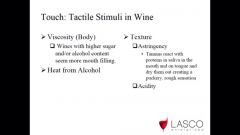![]()
![]()
![]()
Use LEFT and RIGHT arrow keys to navigate between flashcards;
Use UP and DOWN arrow keys to flip the card;
H to show hint;
A reads text to speech;
12 Cards in this Set
- Front
- Back
|
How do we evaluate wine?
|
1. Sight
2. Smell 3. Taste 4. Touch |
|
|
SIGHT - Color Hue, White
|
1. Pale = young, cool region
2. Deep = Mature, warm region, oak barrel |
|
|
SIGHT - Color Hue, Red
|
1. Inky Purple - young
2. Brick Red - age 3. Blue or Orange - acidity levels 4. Purple and Blue - lower 5. Ruby or Orange - higher acidity |
|
|
SIGHT - Color Intensity
|
Intense color means...
1. highly extracted wine - spent more time in skins and seeds. 2. youth in wine - as wine ages, color of wine begins to fade. |
|
|
SIGHT - Bubbles
|
Unintentional bubbles indicate something is wrong with the wine.
|
|
|
SIGHT - legs
|
Thicker legs means higher alcohol content.
|
|
|
SIGHT - sediment
|
Residual particles left over from the wine making process or polymerized strands of phenolic compounds. Not an indication of a flawed or low quality wine.
|
|
|
SMELL - How many odorous compounds are found in wine?
|
around 200
|
|
|
SMELL - How do we smell?
|
Olfactory Epithelium
- molecules enter through nostrils, mouth, rear nasal passages Volatile Compounds - molecules that are able to become airbourne |
|
|
SMELL - how do we smell wine?
|
swirl, hold, slurp
|
|
|
TASTE - what are the six sensations?
|
sweet
sour bitter salty umami fat |
|
|
TOUCH - tactile stimuli in wine...
|

|

